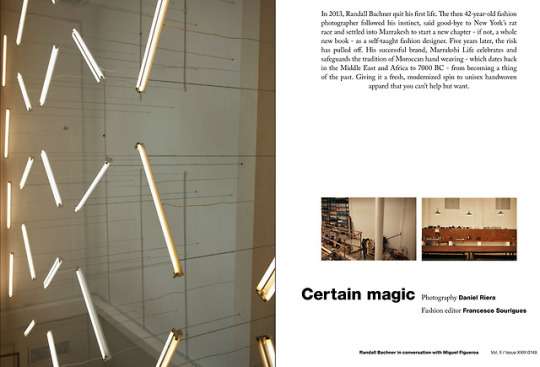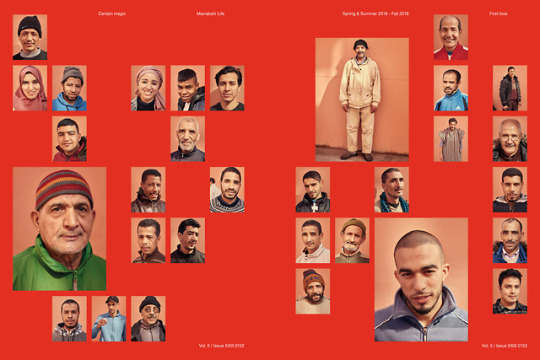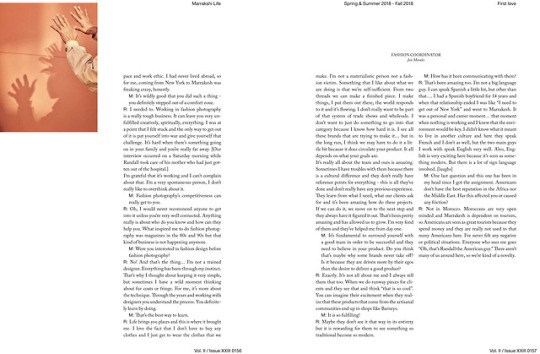#also i do in fact know why it's bc i went to the wholesale shop and also made a pie
Text
I UPPED my calorie count bc I reached my weight goal and now I'm just trying to maintain. so why. do I suddenly find it impossible to stay under my calorie count THERE'S MORE CALORIES AVAILABLE I SHOULD BE UNDERREACHING NOT OVERREACHING EXPLAIN. EXPLAAAAAAIN.
#diet talk#sorry#also i do in fact know why it's bc i went to the wholesale shop and also made a pie#you know what's quite high calorie? buttery pastry.#also cheesy pork pies. also not cheesy pork pies. also the wine gums that were 20p per big bag.
8 notes
·
View notes
Photo





Certain Magic
(From Chaos to Tradition - Randall Bachner Finds Life in Marrakesh)
By Miguel Figueroa
Photographed by Daniel Riera
In 2013, Randall Bachner quit his first life. The then 42-year-old fashion photographer followed his instinct, said good-bye to New York’s rat race and settled into Marrakesh to start a new chapter - if not, a whole new book - as a self-taught fashion designer. Five years later, the risk has pulled off. His successful brand, Marrakshi Life celebrates and safeguards the tradition of Moroccan hand weaving - which dates back in the Middle East and Africa to 7000 BC - from becoming a thing of the past. Giving it a fresh, modernized spin to unisex handwoven apparel that you can’t help but want.
Hi Randall, Marrakshi Life is wonderful! Please, tell me more about it.
Oh, why thank you! We started as a little shop in the Medina working with one weaver, doing one off pieces and then added a tailor. We made one piece, hung it in the shop to see what would happen. When people found us in the Medina it was a sort of discovery and inspired them to do things. We do our own brand, Marrakshi Life [ML] and service production. A lot of fashion people come to Marrakesh and they end up wanting to use our resources of hand weaving and garments, therefore, a big part of our business is working with other brands.
Weaving was losing its popularity in Morocco because they want to modernize everything. They have an appreciation of the tradition but it’s hard to get young people engaged in it and the weavers are getting old, but it’s really nice to be able to sustain weaving and make it cool again. Ariane Goldman’s company Hatch became our first client from New York. She took the risk and gave us a huge production. From there we built a little atelier in the center of Marrakesh outside the Medina and then within six months we had more clients. Last June we moved into a new space that took a few months to build and then we were able to balance production for our brand and our clients.
When you enter into the space you can see the whole process - the spinners, tailors, weavers and from there we have our shop and office. It’s all in one whole warehouse space and we’ve already maxed it out! [laughs] We’re growing at a really cool rate and it’s about how we continue. When you can see the process is really nice for people and they appreciate it. We just shot our first campaign in Uruguay and it was great to go with the brand outside Morocco. I have to think about how I’m going to get the brand outside of Morocco because I’m not really into the whole seasons thing, ML is more resort wear.
You can wear it throughout the year.
Morocco has mild winters. It gets cold sometimes and in that deeper part of winter is when I can least wear the clothes there. I’m now in New York [in February] and I can’t really wear it right now but we are going to start bulking up, working with wools and other warmer fabrics. There are so many possibilities of what you can do with weaving, but in Morocco sometimes it’s very hard to resource materials.
As the brand grows, has there been any interest from younger Moroccan artisans to learn weaving?
The team is growing and it’s really cool. We have our team of weavers and it’s expanding and we are finding younger people engaged in it. The average age was 55 and now the average age is in the 40s. We have a couple of people in their 30s and even in their 20s. We want to start an education program to get engage younger people who don’t have jobs and train them.
Who is the Marrakshi Life client?
Something that’s very important for the brand is that it’s unisex. I like making pieces that are not gender specific at all. If it’s a piece that I couldn't really wear, then we wouldn’t make it. I won’t make very feminine pieces, but I do make very masculine pieces because I like it for men and women. When people do ethnic wear, it has this feminine flow that it’s ok, but not for our brand.
Why Marrakesh?
I had been here before a couple of times and I was amazed at how much you can do there. You see all the artisans and the possibilities but you don’t see an aesthetic that appeals to you, but there are definitely the resources here to do something. I didn’t know about all the problems…
Like?
I had no idea what would it mean to have a business in Morocco. They have their own mentality, pace and work ethic. I had never lived abroad, so for me, coming from New York to Marrakesh was freaking crazy, honestly.
It’s wildly good that you did such a thing - you definitely stepped out of a comfort zone.
I needed to. Working in fashion photography is a really tough business. It can leave you very unfulfilled creatively, spiritually, everything. I was at a point that I felt stuck and the only way to get out of it is put yourself into war and give yourself that challenge. It’s hard when there's something going on in your family and you’re really far away. [Our interview occurred on a Saturday morning while Randall took care of his mother who had just gotten out of the hospital.]
I’m grateful that it’s working and I can’t complain about that. I'm a very spontaneous person, I don’t really like to overthink about it.
Fashion photography’s competitiveness can really get to you.
Oh, I would never recommend anyone to get into it unless you’re very well connected. Anything really is about who do you know and how can they help you. What inspired me to do fashion photography was magazines in the 80s and 90s but that kind of business is not happening anymore.
Were you interested in fashion design before fashion photography?
No! And that’s the thing… I’m not a trained designer. Everything has been through my instinct. That’s why I thought about keeping it very simple, but sometimes I have a wild moment thinking about fur coats or fringe. For me, it’s more about the technique. Through the years and working with designers you understand the process. You definitely learn by doing.
That's the best way to learn.
Life brings you places and this is where it brought me. I love the fact that I don’t have to buy any clothes and I just get to wear the clothes that we make. I’m not a materialistic person nor a fashion victim. Something that I like about what we are doing is that we’re self-sufficient. From two threads we can make a finished piece. I make things, I put them out there, the world responds to it and it’s flowing. I don’t really want to be part of that system of trade shows and wholesale. I don’t want to just do something to go into that category because I know how hard it is. I see all these brands that are trying to make it… but in the long run, I think we may have to do it a little bit because it does circulate your product. It all depends on what your goals are.
It’s really all about the team and ours is amazing. Sometimes I have troubles with them because there is a cultural difference and they don’t really have reference points for everything - this is all they’ve done and don’t really have any previous experience. They learn from what I need, what our clients ask for and it’s been amazing how do these projects. If we can do it, we move on to the next step and they always have it figured it out. That's been pretty amazing and has allowed us to grow. I’m very fond of them and they’ve helped me from day one.
It’s fundamental to surround yourself with a good team in order to be successful and they need to believe in your product. Do you think that’s maybe why some brands never take off? Is it because they are driven more by their egos than the desire to deliver a good product?
Exactly. It’s not all about me and I always tell them that too. When we do runway pieces for clients and they see that and think “that is so cool”. You can imagine their excitement when they realize that these products that come from the artisanal communities end up in shops like Barneys.
It is so fulfilling!
Maybe they don’t see it that way in its entirety but it is rewarding for them to see something so traditional become so modern.
How has it been communicating with them?
That’s been amazing too. I’m not a big language guy. I can speak Spanish a little bit, but other than that…. I had a Spanish boyfriend for 14 years and when that relationship ended I was like “I need to get out of New York” and went to Marrakesh. It was a personal and career moment… that moment when nothing is working and I knew that the environment would be key. I didn’t know what it meant to live in another culture and here they speak French and I don’t as well, but they two main guys I work with speak English very well. Also, English is very exciting here because it’s seen as something modern. But there is a lot of sign language involved. [laughs]
One last question and this one has been in my head since I got the assignment. Americans don’t have the best reputation in the Africa nor the Middle East. Has this affected you or caused any friction?
Not in Morocco. Moroccans are very open minded and Marrakesh is dependent on tourism, so Americans are seen as great tourists because they spend money and they are really not used to that many Americans here. I’ve never felt any negative or political situations. Everyone who sees me goes “Oh, that’s Randall the American guy.” There aren’t many of us around here, so we’re kind of a novelty.
Featured in the Spring 2018 issue of Hercules Universal, First Love.
1 note
·
View note